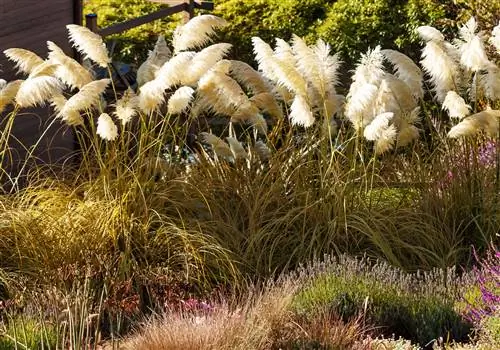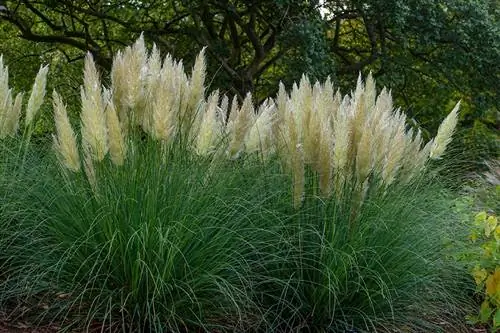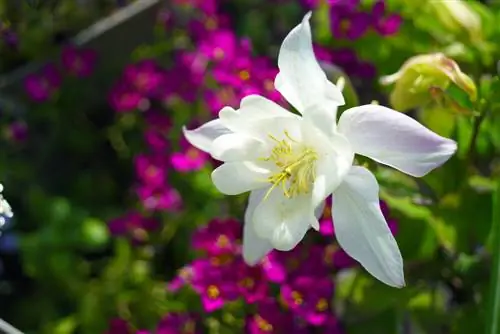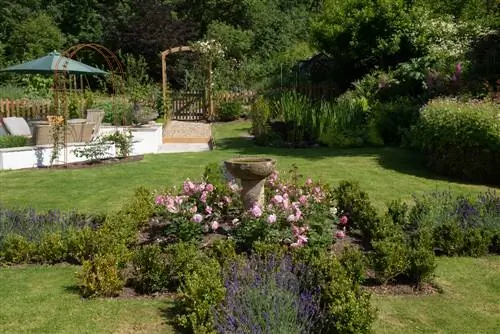- Author admin [email protected].
- Public 2023-12-16 16:46.
- Last modified 2025-01-23 11:20.
Pampas grass is suitable due to its impressive size in combination with other perennials as well as as a solitary perennial in the garden. To incorporate pampas grass into your garden design, the perennial can also be combined with lavender, rue, sedum and other perennials.
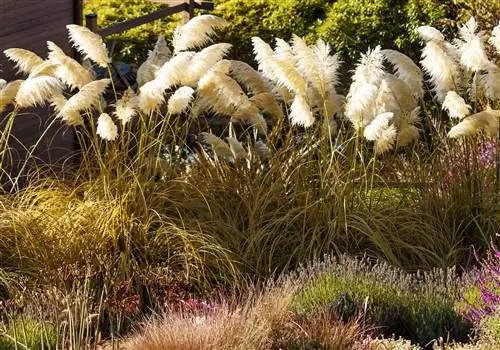
How to combine pampas grass in the garden?
Pampas grass can be combined with flowering perennials such as lavender, asters and coneflowers as well as various grasses such as pennisetum and maidenhair grass. Pay attention to color harmony and sufficient plant spacing for an aesthetic garden design.
What can pampas grass be combined with?
Pampas grass can be combined with flowering perennials such as asters and lavender in shades of blue, purple and white. The best combination for a sunny location is a prairie bed. Plant candlesticks and echinacea in front of the pampas grass and low-growing grasses such as maidenhair grass in empty spaces. Spring flowering plants such as Allium replace the seemingly empty space after pruning in spring until the perennial flowers develop.
Despite its predominantly vertical growth, Cortaderia selloana should be given enough space in width. For this purpose, a planting distance of at least one meter from other plants is recommended. Further tips and advice on planting ornamental grass can be found here.
Pampas grass combined with perennials
In combination with flowering and perennials, the bed can not only become a paradise for birds, but also an insect magnet. Perennials of different heights can create soft transitions to the tall pampas grass. The pampas grass should be arranged in the background.
The following are suitable for combination withPerennials:
- Lavender
- Blue Diamond
- Coneflower
- Aster
- Magnificent candle
- Sedum
Planting Example 1
When combining pampas grass and lavender, it is a good idea to add coneflowers and aster to the bed. This allows for flowering throughout the summer and an impressive play of colors for the individual species.
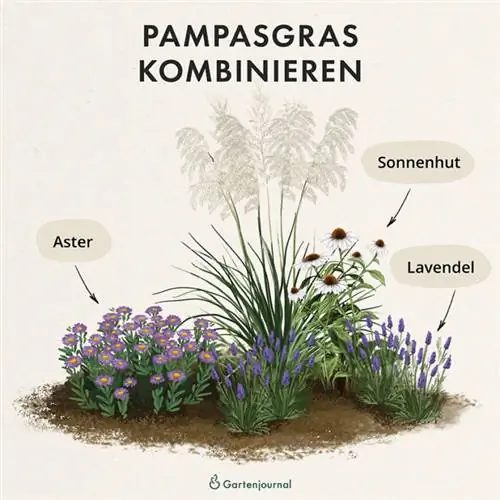
Lavender bushes usually reach a height of up to 60 centimeters and a growth width of up to 90 centimeters. The selected location should be in a sunny spot that also has nutrient-poor and permeable soil. Lavender is particularly popular because of its pleasant scent and high insect attraction. The hardy lavender should be planted in the front area due to its rather low height. Gaps caused by maintaining planting distances can be easily covered by the bushy shrubs.
TheAster is a perennial perennial and is very popular in home gardens due to its variety of colors and moderate maintenance requirements. With a height of up to 1.5 meters, the perennial reaches a considerable size. The white to purple flowers can be admired from August to November. Due to its bushy growth, the aster should be transplanted towards the back of the bed. Please note the minimum distance of one meter that must be maintained so as not to restrict the growth of the individual species.
TheConefloweris, as its name suggests, one of the particularly sun-loving plants. A location in full sun combined with a nutrient-rich and water-permeable substrate ensures splendid development. With a growth height of up to 90 centimeters, it is one of the medium-sized perennials and can easily be planted in the middle bed area.
Planting example 2
Pampas grass and the magnificent candle are another popular combination. Like the ornamental grass, this is one of the taller plants and caresses the sometimes very long stalks. The ensemble is complemented by the stonecrop and the coneflower, which offer an interesting variety in both color and height.
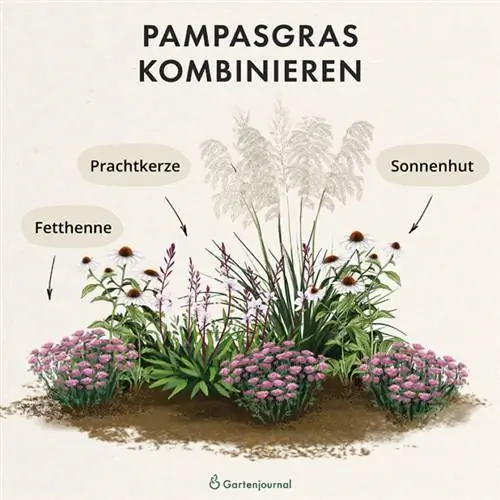
TheMagnificent Candle is one of the permanent bloomers and shows its delicate flowers from June to September. With a growth height of up to 1.5 meters, it should be planted at the back of the field, but beyond that it does not place any great demands on its planting site. This should be in a sunny place and protected from the weather.
TheSedum hen not only impresses in bed planting with its magnificent red flower color, but also offers you equally beautiful leaf colors. The location can be in either a sunny or partially shaded spot, but should have good soil drainage. With regard to nutrient density, caution should be exercised, especially with nitrogen, as this leads to softening of the shoots.
TheConeflower also comes into its own in this planting combination, especially in the middle area of the cultivation area. The yellow flowers in combination with the dark flower heads form a great contrast to the other plants in midsummer. Due to the late flowering period from July to October, the yellow color accents still shine in late autumn.
Pampas grass combined with grasses
The combination with other types of grass, sedges or pampas is also common. Due to the variety of external appearances and color variations, ornamental grasses can easily be combined with each other to create varied plantings. An overview of all common color variations can be found in this article.
The following are suitable for combination withgrasses:
- Pennisetum grass
- Rabbit Tail Grass
- Girl's hair grass
- Panmillet
- Riding grass
- Diamondgrass
TheFeather grass is particularly popular because of its feather-like flower fronds, which are reminiscent of beach grass. Depending on the variety selected, the feather grass reaches a height of between 50 (real feather grass) and 250 (giant feather grass) centimeters. The chosen location should be in a sunny spot that has a water-permeable substrate. An additional supply of nutrients to the plant is not necessary, even if the soil is poor.
A special feature of thePennisetum grass are the spike-shaped flower fronds, which have a white to brownish color. With a height of 1.5 meters, Pennisetum alopecuroides is one of the tall-growing grass species. The ideal location should be in full sun, which also has a nutrient-rich and permeable substrate.
Riding grass can be planted in both a sunny and a partially shaded location. In any case, the soil should have a nutrient-rich and humus-rich structure in order to achieve the best possible result. The maximum growth height is 1.2 meters with a growth width of 80 centimeters.
Since pure grass beds usually only make their big appearance in autumn, it is worth putting spring bloomers such as alliums (or alliums) in the ground. At different heights they accompany the growth of the grasses until they develop in spring.
color harmony
In order to create color harmony in the bed, it is worth usingindividual color accents. Choose up to three shades such as white, pink and hot pink as accent colors for your perennial selection. Shades of blue and purple (e.g. blue diamond, asters) in combination with white (e.g. lavender, asters, coneflower, coneflower) also work. The same principle applies when selecting different grasses. Pay particular attention to the colors that the grasses take on in the fall to create an overall aesthetic look.
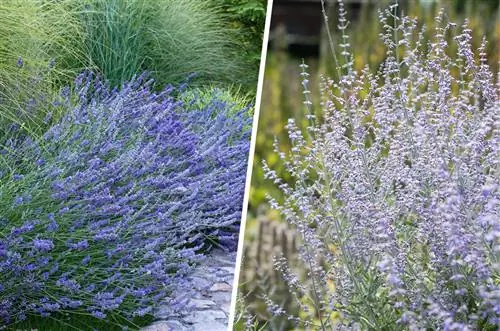
Left: Lavender, Right: Blue Diamond
FAQ
Which location is suitable for pampas grass?
Pampas grass prefers a sunny to partially shaded location, which should also be protected from any weather influences such as wind and rain. In addition, based on the natural occurrence, a nutrient-rich and permeable substrate is recommended, which you should keep as dry as possible.
How much space does pampas grass need?
The planting distance from other plants should be at least one meter, and even 1.2 meters for tall varieties. Planting that is too dense leads to an insufficient supply of nutrients and thus weaker growth. The aforementioned distance must also be maintained when installing a privacy screen.
Do lavender and pampas grass go together?
Lavender and pampas grass can easily be combined with each other, as both the site conditions and general care have a lot of overlap. Due to the significant difference in height, necessary plant gaps can be discreetly covered with the help of lavender.
How to combine dried pampas grass?
Dried pampas grass can also be combined well with various plants in vases. In addition to different colored grasses, eucalyptus, hydrangea, poppy and palm leaf stems are also available.
How is pampas grass combined?
When planting beds, pampas grass should be combined with smaller growing species due to its height. You should stagger them towards the edge of the bed with a falling height in order to create a harmonious picture. There are basically no limits when it comes to choosing individual plants. Only the preferred location conditions should not contradict each other. Asters, lavender and sedum are well suited.

